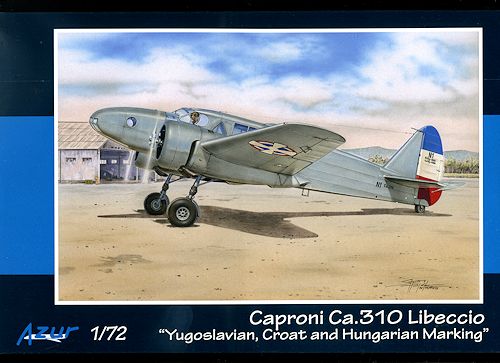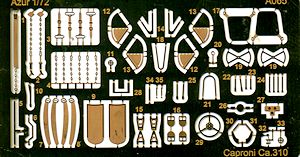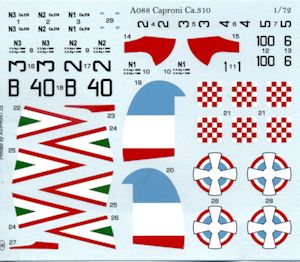
| KIT #: | A088 |
| PRICE: | $28.79 ($32.00 SRP) |
| DECALS: | Three options |
| REVIEWER: | Scott Van Aken |
| NOTES: | Short run with etched and resin parts |

| HISTORY |
The Ca.310 was designed as a low-wing monoplane reconnaissance/bomber, being essentially a version of the semi-military Ca.309 with retractable landing gear and uprated engines. The fuselage was of welded steel tube construction with a covering of light alloy panels and fabric, while the empennage/tail unit was of wooden construction with plywood skin on its fixed portions and fabric covering on control surfaces.
Above the fuselage, mounted in line with the wing trailing edges was a manually operated dorsal turret armed with a single rifle-caliber (7.7 mm/0.303 in) Breda-SAFAT machine gun.
Caproni pinned great hopes on the Ca. 310's effectiveness as a combat aircraft, only to be dashed when its performance fell short of expectations. This lack of performance resulted in both Norway and Hungary being disappointed with the export models they received in 1938. The Ca.310 had been evaluated by the Regia Aeronautica (Italian Air Force) which ordered a small batch. A unit of 16 aircraft was sent to Spain in July 1938 for operational trials as a reconnaissance/bomber by the Italian expeditionary force operating alongside the Nationalist insurgents in the Spanish Civil War.
The Norwegian aircraft were acquired as part of a dried and salted cod (Klippfisk) barter deal between Norway and Italy. The original order, including options, was for 24 aircraft, but after seeing that the aircraft did not perform well, the Norwegian authorities refused to accept any further Ca.310s. Instead, a delivery of 12 Caproni Ca.312s with upgraded engines and improved performance was substituted, but not delivered before the German invasion of Norway on 9 April 1940. A similar scenario occurred with other export contracts, especially with a hoped-for Royal Air Force order for bomber trainers being curtailed during negotiations with Caproni when Italy entered the war as an Axis power.
A series of 12 Ca.310bis were produced for Yugoslavia. This variant differed mainly in having an unstepped, glazed nose. The prototype Ca.310bis served as the development for the Caproni-Begamaschi Ca.311.
The 33 Hungarian Ca.310s returned to Italy were refurbished by Caproni and reissued to the 50˚ Stormo d’Assalto. The Ca.310 was not considered an effective combat aircraft and when it saw service during World War II, it was as a reconnaissance aircraft and as a light bomber in areas where no serious opposition was expected.
Peruvian Aeronautical Corps Ca.310s took part in the July 1941 Ecuadorian-Peruvian war. Together with North American NA.50s, the Peruvian Ca.310s flew bombing missions against Ecuadorian cities and supported Army of Peru ground forces.
One Norwegian example has been partially restored and is displayed at Sola Aviation Museum.
| THE KIT |
 It
is quite nice to finally see an early Caproni twin being done. We have had the
312-315 already produced by Italeri back when it was Italierie and while those
leave a bit to be desired, at least we have them. Those who have wanted to
modify those earlier kits were stymied by the different shape of the rear
fuselage. Now it is no worries as there have been several boxings of this
particular version produced by the MPM gang. This one is in an Azur box, which
is somewhat odd as it is not French.
It
is quite nice to finally see an early Caproni twin being done. We have had the
312-315 already produced by Italeri back when it was Italierie and while those
leave a bit to be desired, at least we have them. Those who have wanted to
modify those earlier kits were stymied by the different shape of the rear
fuselage. Now it is no worries as there have been several boxings of this
particular version produced by the MPM gang. This one is in an Azur box, which
is somewhat odd as it is not French.
 However, it
is still short run along with the resin and photo etch that is the norm with
these kits. The resin is for the engines, engine covers, exhaust, wheels and
some other various bits and pieces. Photo etch is mostly for the cockpit and
includes the typical Italian chain and leather seat harness, which are each a
multi-piece assembly guaranteed to drive you nuts getting it together. Also p.e.
are the gear mud guards and Lilliputian braces. The odd 'pie slice' bits fit on
either side of the engine nacelles to the rear once folded.
However, it
is still short run along with the resin and photo etch that is the norm with
these kits. The resin is for the engines, engine covers, exhaust, wheels and
some other various bits and pieces. Photo etch is mostly for the cockpit and
includes the typical Italian chain and leather seat harness, which are each a
multi-piece assembly guaranteed to drive you nuts getting it together. Also p.e.
are the gear mud guards and Lilliputian braces. The odd 'pie slice' bits fit on
either side of the engine nacelles to the rear once folded.
While there is a fuselage length interior floor, there is nothing past the cockpit. No bombardier's position on this one either so all that clear (depending on the variant you build) will show nothing until you get into the cockpit. A nicely done dorsal turret will use a few of those resin and photo etch bits as well.
Wheel wells are slabs that contain holes for the main gear struts, while the
tail gear uses one of those resin wheels. There are differences in the
various markings options so you need to decide which you wish to do before completing the model. One has the
lower nose glass clear while the others have it painted over (well most of it).
Another option or two includes the slotted engine faces.
you need to decide which you wish to do before completing the model. One has the
lower nose glass clear while the others have it painted over (well most of it).
Another option or two includes the slotted engine faces.
Markings options are for three planes. One is a Yugoslav version from 1940 that is in overall silver. Next is a Croatian version in dark green over light grey with yellow bits under the wings and around the rear fuselage. The third option is a Hungarian AF version that is either sand or light green over grey with dark green splotches on the upper surface. This version has most of the clear panels in the nose unpainted. This latter scheme is pre-war. Instructions are well done with paint information in in Gunze paints. The decal sheet is very nicely done and appears free of registration issues.
| CONCLUSIONS |
For those who like the road less travelled, you have it in this kit and others in the series. I would be surprised if we did not see the fixed gear Ca.309 at some time or another.
| REFERENCES |
http://en.wikipedia.org/wiki/Caproni_Ca.310
August 2013
Thanks to me for picking up the preview kit.
If you would like your product reviewed fairly and fairly quickly, please contact the editor or see other details in the Note to Contributors.